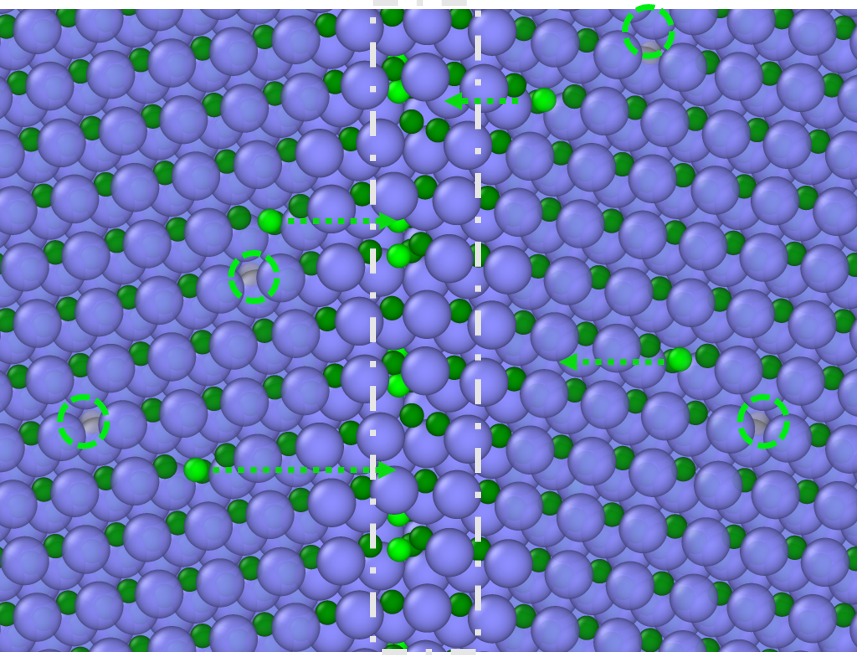
When most people think of ceramics, they might envision their favorite mug or a flowerpot. But modern technology is full of advanced ceramics, from silicon solar panels to ceramic superconductors and biomedical implants.
Many of these advanced polycrystalline ceramics are combinations of crystalline grains that, at the microscopic level, resemble a stone fence held together with limestone mortar. Like that fence, the strength of the ceramic is determined by the strength of the mortar – which in ceramics is the grain boundary, or the areas where the different grains meet.
Previously, most researchers believed the chemistry of these grain boundaries in ceramics was very stable. But a new study by materials science engineers at the University of Wisconsin-Madison (UW-Madison) shows that's not the case.
They found that in the important ceramic material silicon carbide, carbon atoms collect at those grain boundaries when the material is exposed to radiation. This finding could help engineers better understand the properties of ceramics and could aid in fine-tuning a new generation of ceramic materials. The engineers report their findings in a paper in Nature Materials.
Since the 1970s, researchers have been aware of similar radiation-induced segregation in metal alloys. Because metal atoms share electrons freely, they are able to mix and unmix easily. When they are bombarded by ion radiation, some of the atoms in the metals will pop out of place and move toward the grain boundaries. If different types of atoms move at different rates, this process can end up altering the chemistry of the alloy.
Atoms in ceramics are very selective about which neighbors they bond with and the bonds are much stronger than in metals. That's why researchers believed these atoms weren't subject to the same type of segregation. But when Izabela Szlufarska, a professor of materials science and engineering at UW-Madison, began looking closely at the grain boundaries of silicon carbide, that's not what she found.
"In silicon carbide, the silicon and carbon really want to be paired together; they want to be 50% carbon and 50% silicon," she explains. However, when her team ran simulations and also imaged the grain boundaries, they discovered that the carbon concentration was only 45% at the boundaries.
"The chemistry was just really off," she says. "That was the first surprise, since this material really wants to have ordered atoms."
This suggested that silicon carbide might also be susceptible to radiation-induced segregation. So Szlufarska and her team bombarded the substance with ion radiation, finding that, at temperatures between 300°C and 600°C, the grain boundaries experienced carbon enrichment.
At those energy levels, the radiation causes some carbon atoms to pop out of place, creating a pair of defects in the silicon carbide that comprises an empty spot called a vacancy and a loose carbon atom called an interstitial. Those unattached interstitial atoms migrate to the grain boundaries where they accumulate, affecting the material's chemistry.
Besides the fact that researchers simply didn't believe this type of segregation could take place in ceramics, Szlufarska says that, until recently, they also lacked the tools to even investigate the phenomenon. After painstaking fabrication and preparation of the silicon carbide bi-crystals, state-of-the-art scanning transmission electron microscopy conducted at UW-Madison and Oak Ridge National Laboratory allowed the team to resolve the chemical composition along the grain boundaries.
The team believes this phenomenon is likely to occur in other polycrystalline ceramics as well. The process is a double-edged sword: on the one hand, radiation-induced segregation means ceramics are subject to the same types of damage and deterioration at their grain boundaries as metal alloys, though at different temperatures. On the other hand, the segregation could be useful in materials engineering to produce specialized versions of ceramics like silicon carbide, which is used in nuclear energy, jet engines and other high-tech applications.
"Maybe the radiation can be used as a tool to fine tune grain boundary chemistry," says Xing Wang, a co-author of the paper and a professor at Pennsylvania State University, who worked on the research while earning his doctorate at UW-Madison. "That could be useful to us in the future."
This story is adapted from material from the University of Wisconsin-Madison, with editorial changes made by Materials Today. The views expressed in this article do not necessarily represent those of Elsevier. Link to original source.





